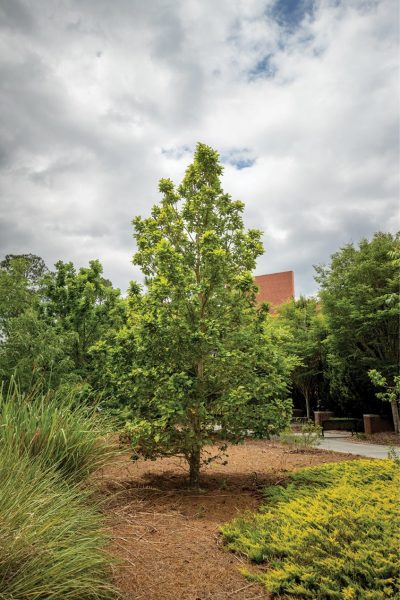Efforts to Preserve A Threatened Tree Species

The Armstrong Campus features a wide variety of unusual plants, including several species native to Mexico. There are 109 native species of oaks in Mexico but many are threatened with extinction for a variety of reasons including climate change and increased human use.
Philip Schretter, the superintendent of grounds operations for the Armstrong Campus, oversees many “only one of” species of plants. And, there’s one that quite literally towers over the others, the Mexican oak species, Quercus insignis. The acorns were collected in Mexico and then grown into plants that were gifted to Georgia Southern where the oak’s remarkable growth has turned into a noteworthy success on the Armstrong Campus.
“This is coming from the cloud forest in southern Mexico, so it’s a prime location for growing coffee,” Schretter said. “And so it’s important to have repositories for that germplasm in other places. We have a lot of plants like that on campus where they are endangered in their native habitats.”
Since its planting in 2012, the plant has grown into a 30-foot-tall tree. Schretter said this rapid growth is exceptional, especially because it’s also growing outside of its natural habitat. There are only a few reports of this type of tree living along the Atlantic Coast, and the others aren’t growing nearly as fast, according to Schretter.
The tree’s story has been gaining notoriety through online stories and publications within the horticulture community, including a recent article for the International Oak Society.
It’s not just the story that’s getting out. The success of the Armstrong Campus tree may very well spread to other parts of the United States. The tree flowered and fruited for the first time last year, which will allow the University to collect its acorns and share them with other universities in areas suitable for the Mexican oak.
“We’ll propagate our own, but we’ll also share them with other places,” Schretter said. “And I hate having just one of anything on campus because if it dies, you don’t have anymore. So we will plant some other ones on campus when we do get some acorns.”
The Mexican oak can be found on the eastern side of the Student Union on the Armstrong Campus and is next to Compass Plaza.
